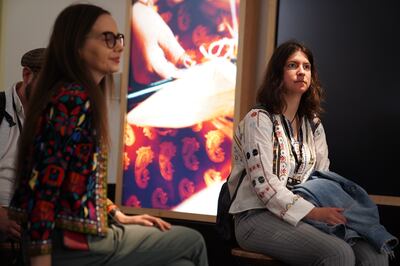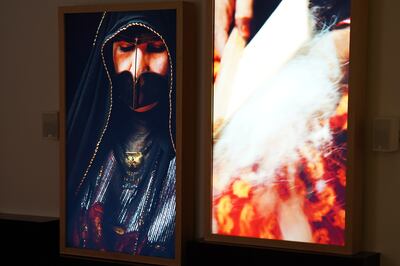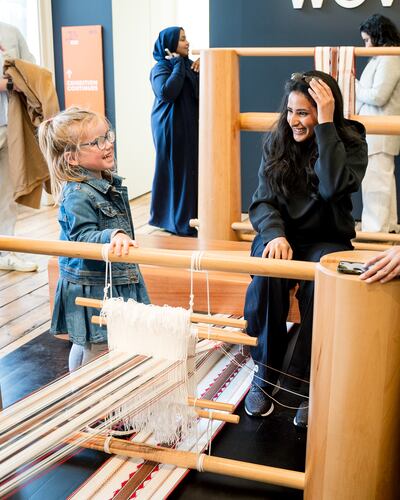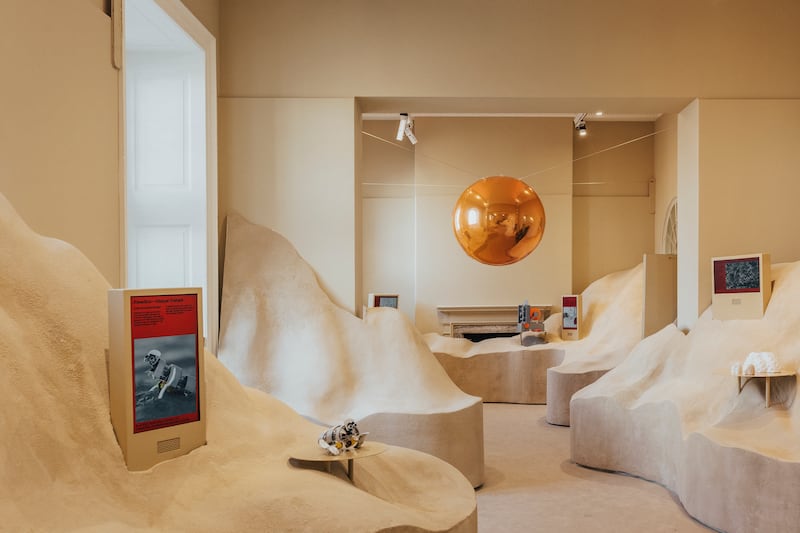This year's London Design Biennale, running under the theme of Global Game: Remapping Collaborations, has mostly eschewed the creative industry's tendency to propel itself towards futuristic solutions.
Instead, it has doubled down on design techniques that already exist globally: earthenware blocks of the type traditionally used across Africa and the Middle East; partition walls made of paper, which the Japanese firm Ban is using for shelters for Ukrainian refugees; bread-baking from Austria.
Outside, a structure made of rusted steel tubes rustles in the wind – the installation Openwork by the Turkish designer Melek Zeynep Bulut – to reveal itself as a standing form of wind chimes. The message is clear: not everything old is worth moving on from.
For the three pavilions participating from the Gulf – Abu Dhabi, Dubai and Saudi Arabia – this means bringing traditional practices to London to show how Bedouins survived and made crafts amid a scarcity of resources.
Abu Dhabi and Saudi Arabia’s pavilions examine stages in the process of sadu weaving, a flat loom-based technique that allows for intricate geometric patterns. The textiles produced were traditionally used for decorative items and soft furnishings.

In 2020, sadu was inscribed by Unesco as part of the intangible cultural heritage of humanity and the Department of Culture and Tourism – Abu Dhabi has taken the lead on maintaining and prioritising the skills, which were once feared to be dying out.
Azza Alsharif, who designed the London installation, studied textiles at London's Central St Martins and, when she returned to the UAE, began training in the ancient craft. Now she works at the department integrating the practice into school and university curricula and advising House of Artisans, a community initiative set up by the UAE government, on it.
For her video Formation of Soof, Alsharif isolated one element of the weaving itself: the laborious process of spinning the wool. Traditionally, after men sheared the goats, Bedouin women would slowly and painstakingly transform the fuzzy balls of wool into tightly spun threads of yarn that they could then work into the flat weaves.
Alsharif developed the work with a team from NYU Abu Dhabi, Qasr Al Hosn and House of Artisans, spotlighting the women’s hands. The work was awarded best interpretation of the biennial's theme last week.
“The audio-visual installation focuses on the movement and the flow of these women,” she explains. “When you see it in real life you miss these details. We wanted to show it in an immersive manner so that you can see the real depth of these women’s skills.”
Bedouin openness
Sadu is the most common handicraft across Abu Dhabi, related more to inland, desert practices rather than traditional coastal lives. Beyond the UAE, it is shared across the Gulf – notably also in Saudi Arabia, whose pavilion just across the courtyard at Somerset House looked at a subsequent step in the craft’s process: the weaving itself.

For Woven, Ruba Alkhaldi and Lojain Rafaa created an exaggeratedly large loom to which they invite the public to sit down and have a go. They estimate that over the month of the biennial, they will be able to weave 50 metres, which they will then display in Saudi Arabia and internationally.
The pair wanted to make the loom easier for novice weavers, in what Alkhaldi calls a symbolic gesture of the kingdom’s openness, while also preserving the roots of what Bedouin weaving would have been like.
“Women used to set up sticks in the desert and create their looms based on that,” says Alkhaldi. “We have tried to maintain that with the elements of the design: it has wooden columns and rods that mimic the same branches. We didn't want to turn it into a machine – we wanted it to look authentic.”
Supported by the Ministry of Culture, Alkhaldi and Rafa worked for more than six months with different prototypes for the jumbo loom in order to achieve the necessary tension for the warp of the material. Then, they invited senior sadu weavers from Saudi Arabia to sit down and start the geometric pattern on display, unfinished, in London.
The shift in the textile from the senior weavers from Saudi Arabia to the amateur punters from London is immediately noticeable: from a strict, tight pattern to a loose, unkempt weft. The most magical part, says Alkhaldi, is that testing the structure and later weaving reactivated the loom’s traditional social role.
“Women in the past used to gather together and start weaving to support each other and to talk among themselves,” says Alkhaldi. “One of the interesting things is that while people were using it [in the Saudi workshops], they started sharing their own memories and personal stories.

"Some of them said: 'This reminds me of my grandmother, of my mother'. We started to have dialogues about what type of direction and values will be most promising in the future. So the thing that I'm really proud of is that we recreated that experience in the past where women used to speak and talk and think about the future together.”
Looking forward
The idea of the future is on display clearest at Dubai’s pavilion, where Mula design studio’s Abdalla Almulla compared the desert environment traversed by the Bedouins to that of the Martian territory explored by the Emirates Mars Mission's Hope rover.
“Camel caravans were a time of humans collaborating with animals to form and navigate these landscapes,” he says. “But even though we come from this harsh desert landscape, we have always been forward-thinking – most recently with the Hope mission.
"I was thinking, how can I connect these two? How can I allow people to experience the two contrasting landscapes of Dubai and the two contrasting types of collaborations happening in Dubai?”
Almulla, in a project by Dubai Culture, transformed the 19th-century rooms of Somerset House into desert dunes. He and his team built undulating structures, with a meandering path snaking through the sand-covered installation titled And Beyond. A large metallic red orb hangs from the ceiling, reflecting the dunescape back to the viewer not as one of Dubai, but as the otherworldly terrain of Mars.
“As visitors look at themselves in the sphere,” says Almulla. “They feel that they're walking on the surface of Mars, so they will be simultaneously walking on both landscapes.”
The dunes also contained ideas from Prototypes for Humanity – the programme that grew out of Art Dubai’s Global Grad Show – that respond to the world’s increasing crises, such as a foldable raft in case of emergency flooding, a purification system designed specifically for polluted air underground and a surprisingly charming solar-powered device that looks like a small turtle and lays seeds in the desert.
It was a quirk of the commissioning procedure that meant that the two UAE pavilions were each invited separately – but they made a nice pairing at Somerset House, separated by a corridor and covering visions of past and present – and of course, the future, which for Almalla says Hope symbolises for this generation.
“Our generation, growing up, we never thought of things [like the Hope mission] as something possible,” he says. “But then when it happens, you feel nothing is impossible and you can achieve it. You’re here at the right time and the right moment to achieve whatever you want.”







